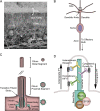Olfactory cilia: linking sensory cilia function and human disease
- PMID: 19406873
- PMCID: PMC2682445
- DOI: 10.1093/chemse/bjp020
Olfactory cilia: linking sensory cilia function and human disease
Abstract
The olfactory system gives us an awareness of our immediate environment by allowing us to detect airborne stimuli. The components necessary for detection of these odorants are compartmentalized in the cilia of olfactory sensory neurons. Cilia are microtubule-based organelles, which can be found projecting from the surface of almost any mammalian cell, and are critical for proper olfactory function. Mislocalization of ciliary proteins and/or the loss of cilia cause impaired olfactory function, which is now recognized as a clinical manifestation of a broad class of human diseases, termed ciliopathies. Future work investigating the mechanisms of olfactory cilia function will provide us important new information regarding the pathogenesis of human sensory perception diseases.
Figures



References
-
- Andres KH. Der olfaktorische Saum der Katze. Z Zellforsch Mikrosk Anat. 1969;96:140–154. - PubMed
-
- Andrews D, Nelson DL. Biochemical studies of the excitable membrane of Paramecium tetraurelia. II. Phospholipids of ciliary and other membranes. Biochim Biophys Acta. 1979;550:174–187. - PubMed
-
- Avidor-Reiss T, Maer AM, Koundakjian E, Polyanovsky A, Keil T, Subramaniam S, Zuker CS. Decoding cilia function: defining specialized genes required for compartmentalized cilia biogenesis. Cell. 2004;117:527–539. - PubMed
-
- Baker H, Genter MB. The olfactory system and the nasal mucosa as portals of entry of viruses, drugs, and other exogenous agents into the brain. In: Doty RL, editor. Handbook on olfaction and gustation. New York: Informa Health Care; 2003. pp. 909–950.
Publication types
MeSH terms
Grants and funding
LinkOut - more resources
Full Text Sources
Medical

